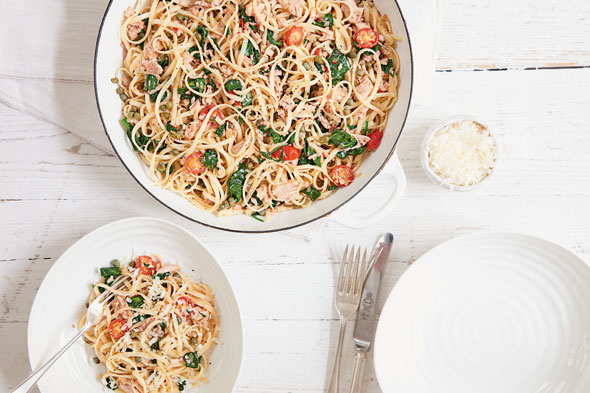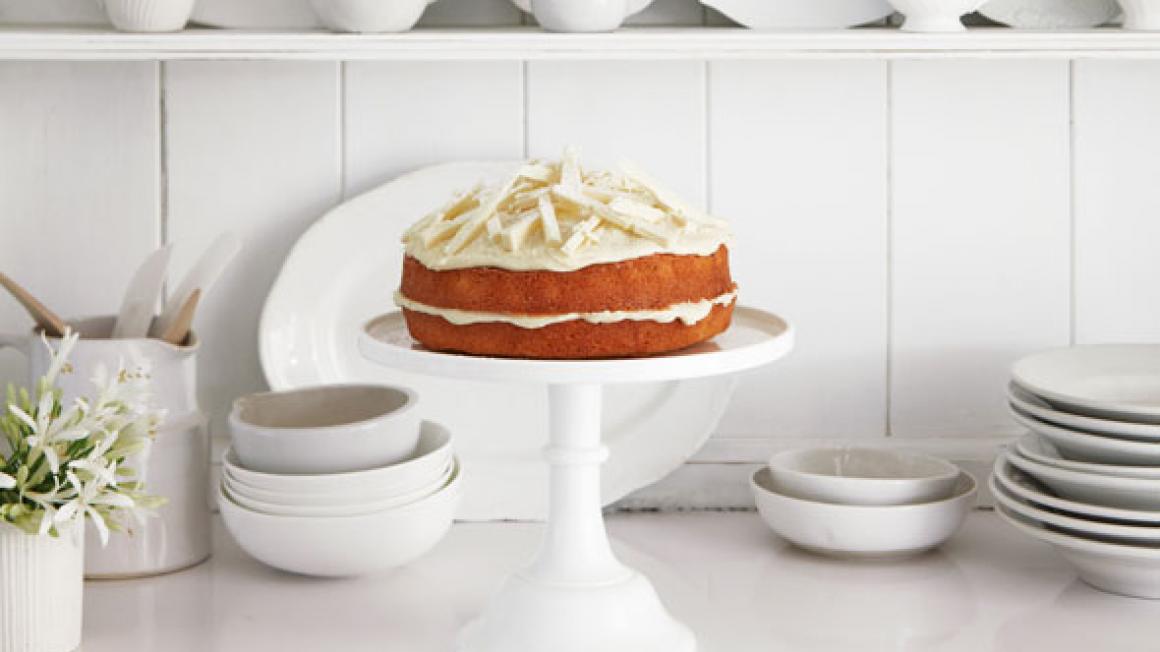Simply Yummy
Cardomom sponge with white chocolate icing (pictured above)
Serves 8The cake can be made and iced up to a day ahead.
225g butter, softened, plus extra for greasing
4 eggs, beaten
225g caster sugar
225g self-raising flour
1tsp baking powder
12 cardomom pods
50g good-quality white chocolate, to decorate
For the icing
100g good-quality white chocolate (see tip)
50g butter, softened (see tip)
75g full-fat cream cheese
200g icing sugar, sifted
½ tsp vanilla extract
You will need two 20cm round sandwich cake tins. Preheat the oven to 180C/160C fan/gas mark 4, then grease the tins with butter and line the bases with baking paper.
Place the butter and eggs in a mixing bowl with the sugar, flour and baking powder and beat together, by hand or using an electric hand whisk, until combined.
Bash the cardomom pods with a rolling pin on a chopping board to release the seeds. Grind the seeds until fine using a pestle and mortar then stir this into the cake batter. Pour the batter into the prepared tins and smooth the tops.
Bake for about 25 minutes until golden brown and springy to the touch. Allow to cool in the tins for 5 minutes and then turn out and cool on a wire rack.
Make the icing. Place the white chocolate in a heatproof bowl set over a pan of simmering water. Stir until melted and smooth. Take care not to let the chocolate get too hot (see tip). Set aside to cool and thicken. Whisk the butter and cream cheese together until fluffy and soft.
Whisk in half the icing sugar, then add the vanilla extract and remaining icing sugar and whisk again. Stir in the melted white chocolate to combine and then transfer to the fridge to chill for about 20 minutes until thickened enough to spread on the cake.
Divide the icing between the two cakes, spreading half on one, sandwiching with the second cake and using the rest of the icing to cover the top. Use a sharp knife to cut the remaining white chocolate into angular shards and arrange over the top of the cake for decoration. Cut into wedges to serve.
Tips
It is important to buy white chocolate with a high cocoa butter content (Belgian is best) as it is less likely to split. Make sure the butter for the icing is softened or it will not blend smoothly with the cream cheese and will leave lumps. Don’t overheat the white chocolate or the icing will not set.
Roast rack of pork with sage and lemon rub
Serves 6The pork can be cooked up to 2 days ahead if serving cold.

2 onions, thickly sliced (about 1cm thick)
1.7kg forerib of pork loin, skin scored
coarse sea salt
4 tbsp finely chopped sage leaves
finely grated zest of 1 lemon
For the gravy
25g butter
25g plain flour
1tsp lemon juice
1 tsp redcurrant jelly
a dash of Worcestershire sauce
salt and ground black pepper
Preheat the oven to 220C/200C fan/gas mark 7.
Put the onion slices into a small roasting tin, sit the pork joint on top of the onions and run 1½-2 tablespoons of coarse salt into the scored skin.
Place the sage in a bowl with the lemon zest and ½ tablespoon of coarse salt. Mix together and, using your fingers, rub the mixture into the skin of the joint.
Roast in the oven for 30 minutes until golden and starting to crisp. Reduce the oven temperature to 200C/180C fan/ gas mark 6 and continue to roast for 1 hour and 25 minutes or until the pork is cooked through, the juices are running clear, and the crackling is crisp and golden (see tip). Carefully remove the pork joint from the tin and set aside to rest for about 10 minutes, covered with foil.
Make the gravy. Add 450ml of water to the roasting tin and bring to the boil on the hob, scraping the base of the tin with a wooden spoon to incorporate the caramelised juices into the liquid to create a stock. Remove from the heat and strain into a jug.
Melt the butter in a saucepan, add the flour and whisk to form a roux. Cook for 30 seconds, then blend in the homemade stock over a high heat, whisking all the time and boiling until thickened. Season to taste with salt and pepper, the lemon juice, redcurrant jelly and a dash of Worcestershire sauce. Carve the pork and crackling and serve with gravy.
Tip
A hot oven and salt give the best crackling. If yours is not quite crisp enough, slice off the crackling with a knife, lay it on a baking sheet and return to the oven to crisp up.
Tuna and spinach linguine
Serves 6The pasta can be cooked ahead, drained and refreshed in cold water up to 4 hours before cooking the rest of the dish.

350g linguine
2 x 200g tins of tuna in olive oil, drained and oil reserved
2 garlic cloves, crushed
4 tinned or bottled anchovy fillets, finely chopped
2 large shallots, finely chopped
1 fresh red chilli, deseeded and finely chopped
2 tbsp drained baby capers
12 cherry tomatoes, halved
225g baby spinach leaves, coarsely shredded
salt and ground black pepper
To serve
Finely grated zest and juice of 1 small lemon
2 tbsp finely grated Parmesan cheese
Bring a large pan of salted water to the boil, add the linguine and cook according to the packet instructions, then drain.
Meanwhile, measure 2 tablespoons of oil reserved from the tuna tins into a large frying or sauté pan. Add the garlic, anchovies, shallots and chilli and fry over a high heat for 5-6 minutes until the shallots have softened. Add the capers, cherry tomatoes and spinach leaves and toss until the spinach is wilting.
Tip the drained linguine and the flaked tuna into the pan. Season with salt and pepper and carefully toss together until combined (see tip), adding more oil if the mixture seems too dry.
Tip into a serving bowl and sprinkle with the lemon zest and juice and grated Parmesan to serve.
Tip
You have to be quick with the frying and tossing together or the pasta will break up and everything will stick together!
Foolproof Cooking by Mary Berry, with photography by Georgia Glynn Smith, is published by BBC Books, £25.


